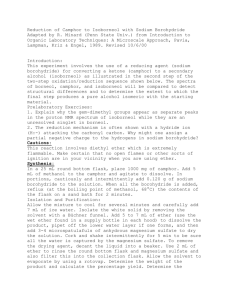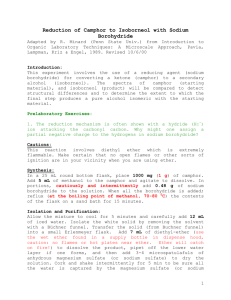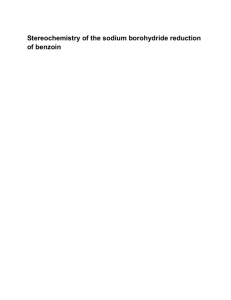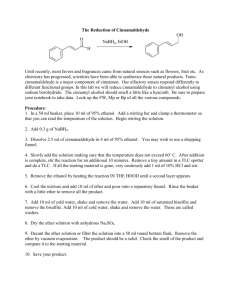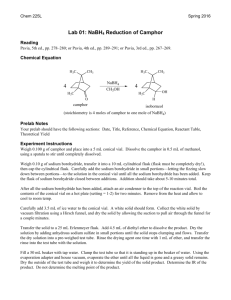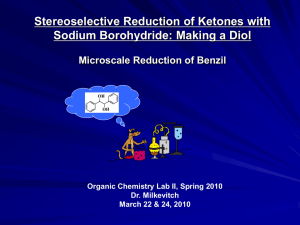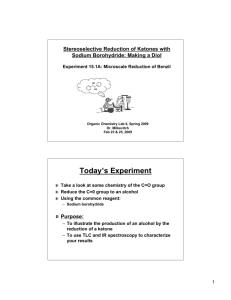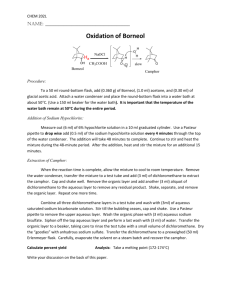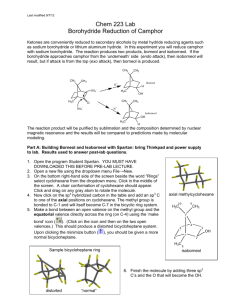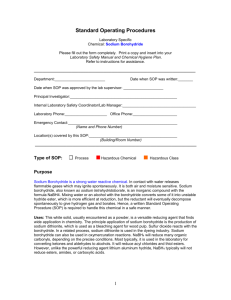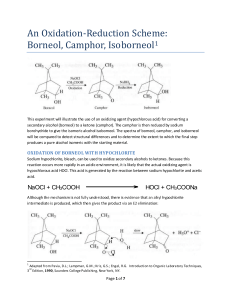C:\Documents and Settings\Steve Murov\My Documents
advertisement
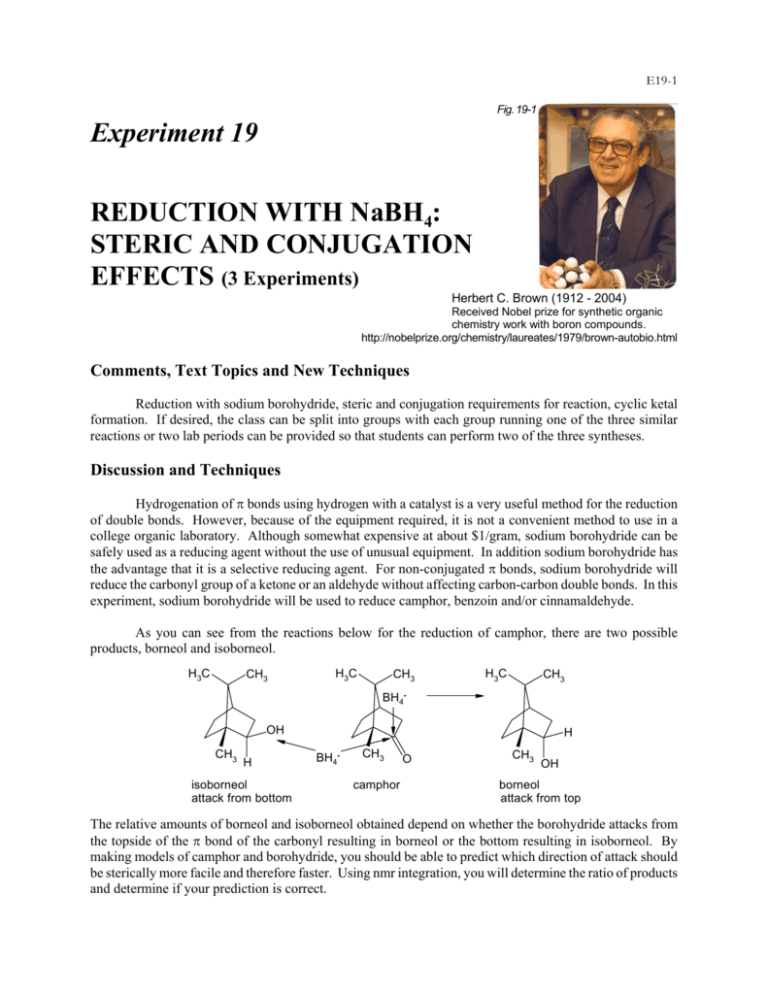
E19-1 Fig. 19-1 Experiment 19 REDUCTION WITH NaBH4: STERIC AND CONJUGATION EFFECTS (3 Experiments) Herbert C. Brown (1912 - 2004) Received Nobel prize for synthetic organic chemistry work with boron compounds. http://nobelprize.org/chemistry/laureates/1979/brown-autobio.html Comments, Text Topics and New Techniques Reduction with sodium borohydride, steric and conjugation requirements for reaction, cyclic ketal formation. If desired, the class can be split into groups with each group running one of the three similar reactions or two lab periods can be provided so that students can perform two of the three syntheses. Discussion and Techniques Hydrogenation of π bonds using hydrogen with a catalyst is a very useful method for the reduction of double bonds. However, because of the equipment required, it is not a convenient method to use in a college organic laboratory. Although somewhat expensive at about $1/gram, sodium borohydride can be safely used as a reducing agent without the use of unusual equipment. In addition sodium borohydride has the advantage that it is a selective reducing agent. For non-conjugated π bonds, sodium borohydride will reduce the carbonyl group of a ketone or an aldehyde without affecting carbon-carbon double bonds. In this experiment, sodium borohydride will be used to reduce camphor, benzoin and/or cinnamaldehyde. As you can see from the reactions below for the reduction of camphor, there are two possible products, borneol and isoborneol. H 3C CH3 H3 C CH3 H 3C CH3 BH4OH CH3 H isoborneol attack from bottom H BH4- CH3 camphor O CH3 OH borneol attack from top The relative amounts of borneol and isoborneol obtained depend on whether the borohydride attacks from the topside of the π bond of the carbonyl resulting in borneol or the bottom resulting in isoborneol. By making models of camphor and borohydride, you should be able to predict which direction of attack should be sterically more facile and therefore faster. Using nmr integration, you will determine the ratio of products and determine if your prediction is correct. E19-2 The reduction of benzoin with sodium borohydride is another example where the stereochemistry of the product can be used to elucidate the sterero preference of the reaction. Again, by examining models, it should be possible to predict whether the product will be the erythro diol or the threo diol. erythro (meso) O OH Ph C H C threo NaBH4 Ph OH H Ph H Ph and/or Ph H H Ph OH OH OH acetone/ acetone/ Ph Ph Ph CH3 O O CH3 O O CH3 CH3 Ph diastereotopic methyls enantiotopic methyls Although the melting range and ir of the product should provide some evidence regarding which product is formed, stronger evidence is provided by an examination of the H-nmr of the product formed when the diol is reacted with acetone to form a ketal. Notice that the threo form yields a ketal with the methyl hydrogens magnetically equivalent and therefore yielding one signal. However, for the erythro form the two methyls are in different environments and yield two signals. The number of methyl signals provides an easy way to distinguishing between the two possible products The reaction of cinnamaldehyde with sodium borohydride is another interesting example of reduction with this useful reagent. The starting material, cinnamaldehyde and the possible products are all expected to be odiferous and potentially useful in products used to modify odor such as perfumes. As mentioned above, sodium borohydride selectively reduces carbonyls in the presence of carbon - carbon double bonds. However, exceptions can occur when the double bond is conjugated. In this case, it is possible to have 1,2 (direct addition) or 1,4 (conjugate addition) or both. Your goal today will be to react cinnamaldehyde with sodium borohydride, separate, purify and identify the product and determine the nature of the addition. OH H C H2 C C O H H O H C C C H or H C C H H NaBH4 H+/H2O OH H H or H C H C H C H2 C H E19-3 Procedure Reduction of camphor. Add 0.50 g of camphor and 5 mL of methanol to a dry (it is important that all glassware be dry) 25 mL round bottom flask. Fit the flask with a magnetic stirring bar and a Claisen adapter containing a reflux condenser in the side arm. Stopper the vertical arm. Mount the apparatus in a room temperature water bath (crystallizing dish or beaker) on top of a heater stirrer unit. After the bath temperature has been established, add 0.30 grams of sodium borohydride to the stirred solution through the vertical arm. Some bubbling may occur as a result of reaction of sodium borohydride with methanol. After addition is complete, heat the water bath to gently boil the methanol for a couple of minutes. Allow the mixture to cool for a few minutes and pour it onto about 15 g of crushed ice in a small beaker. Use very small portions of methanol to wash the round bottom to assure transfer of all of the contents of the flask to the beaker. After the ice melts, vacuum filter using a Hirsch funnel and a filter flask to collect the solid from the beaker. Because air drying for several days would result in substantial loss of product due to sublimation, an alternative drying procedure should be used. The solid should be dissolved in about 20 mL of ether and the ether layer dried completely with anhydrous magnesium sulfate. Carefully decant the ether layer, wash the solid with a small amount of ether and combine the ether layers in a small filter flask. Insert a magnetic stirring bar in the flask and mount it in a room temperature water bath on a stirrer unit in a hood. Stopper the flask and connect the side arm to an aspirator via a trap. The ether should rapidly evaporate when the stirrer and aspirator are turned on. Determine the mass, percent yield and the melting range of the product. Run an 1H-nmr on the dried product and determine the borneol to isoborneol ratio. The borneol hydrogen on the OH bearing carbon resonates between 3.95 and 4.2 δ and the corresponding isoborneol hydrogen resonates between 3.55 and 3.8 δ. The ratio of the integrations for these two peaks should give you the desired information Reduction of benzoin. Add 2.00 g of benzoin to an Erlenmeyer flask equipped with a magnetic stirring bar containing 20 mL of ethanol. Stir until a suspension results. Add 0.40 g of NaBH4 to the flask and stir for 10 minutes. Cool the solution in an ice bath and add 30 mL of water. Follow this with the dropwise addition of 1 mL 6 M HCl to the stirred solution. Add an additional 10 mL of water and stir for 10 more minutes. Vacuum filter to collect the crystals of hydrobenzoin and wash with cold water. Place some crystals aside to dry for a melting range determination and an ir spectrum. Set up a reflux apparatus with a 100 mL round bottom flask. Add 1.00 g of hydrobenzoin, 0.30 g of anhydrous iron(III) chloride and 30 mL of anhydrous acetone for 20 minutes. Cool the solution and dilute with 10 mL of 10% aqueous K2CO3 and 50 mL of water. Transfer the mixture to a separatory funnel and extract with two twenty mL portions of methylene chloride. Combine the two organic extracts and discard the aqueous solutions. Return the methylene chloride solution to the separatory funnel and wash with 25 mL of water. After separating the layers, dry the organic phase over anhydrous Na2SO4. Using a rotary evaporator or an alternative, evaporate the methylene chloride. Dissolve the resulting oily residue in 15 mL of boiling petroleum ether (30-60oC) and allow the solution to cool. Any crystals at this point are probably unreacted hyrobenzoin and should be removed by filtration. Concentrate the remaining liquid portion to about 4 mL by evaporating off the petroleum ether. Cool the remaining solution in an ice bath and scratch the inside of the flask if necessary to induce crystallization. Collect the crystals by filtration and wash with a small amount of cold Fig. 19-2 petroleum ether. Run an H-nmr spectrum of the crystals in deuterochloroform. E19-4 Reduction of cinnamaldehyde. Add 10 mL of methanol and 1 g of cinnamaldehyde to a 50 mL round bottom flask equipped with a magnetic stirring bar. Mount the apparatus in a room temperature water bath (crystallizing dish or beaker) on top of a heater stirrer unit. With a spatula, slowly add 0.30 grams of sodium borohydride to the stirred solution. Some bubbling may occur as a result of reaction of sodium borohydride with methanol. Stir the mixture for about 15 minutes. Evaporate to remove the methanol. Add about 10 mL of water to the flask and stir. Add 10 mL of dichloromethane and transfer the mixture to a separatory funnel. Wash the original flask with 5 mL of dichloromethane and add it to the separatory funnel. Shake, separate and return the organic phase to the separatory funnel. Wash the organic layer twice with 10% sodium chloride solution and dry the organic layer over magnesium sulfate. After decanting or filtering to remove the magnesium sulfate, evaporate the dichloromethane. Identify the product using ir and H-nmr and determine the percent yield of the product. References Pavia, D. L., Lampman, G. M. Lampman, Kriz, G. S. Organic Laboratory Techniques: Small-Scale Approach, 1st ed., Saunders, 1998, pp. 184-189. Zanger, M.; McKee, J. R. Small Scale Syntheses: A Laboratory Textbook of Organic Chemistry, W. C. Brown, Publishers, 1995, pp. 221- 225. Palleros, D. R. Experimental Organic Chemistry, Wiley, 2000, p. 453. Brucie, P. Organic Chemistry, 3rd ed., Prentice Hall, 2002, p. 770. Rowland, A. T. J. Chem. Educ., 1983, 60, 1084. LeFevre, J. http://www.cerlabs.com/experiments/10875407153.pdf E19-5 Prelaboratory Preparation - Experiment 19 First, be sure to list all the goals of the experiment. Consider the oxidation state of hydrogen in sodium borohydride. Is there any connection between the oxidation number and the tendency for sodium borohydride to act as a reducing agent? Calculate the theoretical yield of products. For the camphor reduction, based on your analysis of models of camphor and borohydride, predict which product should dominate at room temperature and at 60oC. Explain how the product ratio will be determined using melting points and nmr. For the benzoin reduction, based on your analysis of models of benzoin and borohydride, predict which product should dominate at room temperature. Explain how the product structure will be determined using melting points, ir and nmr. For the cinnamaldehyde reduction, develop a procedure using ir and/or nmr for determining which product has been formed. Locate this type of reduction on the Reaction-Map of Organic Chemistry in Appendix C and include the reaction number in your report. Observations Report all relevant observations including, masses and melting ranges and spectra. Conclusions This section should include the following: 1. Were the goals of the experiment achieved? Explain your answer. 2. How could the percent yield and recoveries have been improved? 3. Would the synthetic procedure used be useful as a preparative method the product? Explain your answer. For camphor: 4. What were the product ratios determined by H-nmr? 5. Did the product ratios agree with your predictions? Explain your answer. For benzoin: 6. What were the product ratios determined by H-nmr? 7. Did the product ratios agree with your predictions? Explain your answer. 8. Your starting material was racemic benzoin. Would the outcome have been different if you had used one of the enantiomers of benzoin? 9. Evaluate and compare the strength of the evidence for product structure from melting ranges, ir and H-nmr. For cinnamaldehyde: 10. Which product if any formed? Explain your evidence in detail. 11. Generally, direct or 1,2 addition occurs with sodium borohydride for conjugated aldehydes and conjugate or 1,4 addition occurs for conjugated ketones. Do your results agree with this generalization? Explain your answer. 12. Does the product have an agreeable odor? 13. Use the Internet to determine the LD50 of the product? Could the product be safely used in cosmetic products? Explain your answer.
